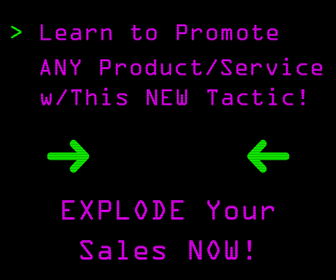 It’s true that assumptions can drastically hurt business and in some cases, ruin it for good. Unfortunately, many online companies don’t succeed because business owners are blind to what could happen. Being blind leads to damaging effects that are hard to come back from. As an entrepreneur, it’s natural to devote time and energy to an online business while spending money on products and setting up a website and services. We discuss how to set up an incredible online business and what to do and what not to do during our free webinar training. Even if an online company takes off, like with many entrepreneurs, it’s easy to be stubborn. No one likes others telling them what they're doing incorrectly. However, this type of mentality can hurt a business in the long run.
It’s true that assumptions can drastically hurt business and in some cases, ruin it for good. Unfortunately, many online companies don’t succeed because business owners are blind to what could happen. Being blind leads to damaging effects that are hard to come back from. As an entrepreneur, it’s natural to devote time and energy to an online business while spending money on products and setting up a website and services. We discuss how to set up an incredible online business and what to do and what not to do during our free webinar training. Even if an online company takes off, like with many entrepreneurs, it’s easy to be stubborn. No one likes others telling them what they're doing incorrectly. However, this type of mentality can hurt a business in the long run.
You’re the Best
You may feel like you’re amazing and so is your business, but Entrepreneur reminds entrepreneurs that there are always ways to improve. And yes, improving is still possible even if you’re doing amazingly well with your online business.
I have yet to meet an entrepreneur who doesn’t believe his or her product or service is the best. I’m no different. I “know” my business is superior. You probably would say the same about your company, too. There’s only one, glaring problem: If you think you’re already doing everything you can, there’s no room to improve.
Odds are, you aren’t viewing yourself in an accurate light — and you’re unlikely to correct that vision on your own. It’s like trying to be objective about your own children. Bring in a qualified, credible someone from the outside and approach your conversations with a learner mindset.
Revenue Plan
Do you have an adequate revenue plan? You may think that your revenue plan is the bomb.com, but Business Insider begs to differ. Check out their advice on why coming up with a sufficient revenue plan is essential to the growth of an online business.
Notice that the traditional product introduction model leads to a product launch and the execution of a revenue plan. The revenue numbers and revenue model came from a startups original Business Plan. A business plan has a set of assumptions (who's the customer, what's the price, what's the channel, what are the product features that matter, etc.) that make up a business model. All of these initial assumptions must be right for the revenue plan to be correct. Yet by first customer ship most of the business model hasn't been validated or tested. Yet startups following the traditional product introduction model are organized to execute the business plan as if it were fact.
Unless you were incredibly lucky most of your assumptions are wrong. What happens next is painful, predictable, avoidable, yet built into to every startup business plan.
You’re Well-Known in Your Market
If your online business has grown tenfold, you may feel like you’re on top of the world. Even though you have the right to be excited Entrepreneur reminds you to get off your high horse and remember not everyone knows you. It’s up to you to continue to get the word out so that your business continues to succeed.
Among my businesses is a pizza restaurant that’s operated for a decade in a town of about 5,000 people. A few years ago, while shopping a block away, I introduced myself to the store’s owner and mentioned my own business. “I’ve never heard of that place,” my fellow entrepreneur said. “Where is it?” I walked with her to the front of her store and pointed to my restaurant.
I assumed everyone in town noticed my shop more than they actually did. It was a good reminder to keep pushing to break through the noise, even a smaller competition pool. Your sales could be suffering from obscurity without your even realizing it.
Frames Become Blinders
Harvard Business Review effectively summarizes how common frames (or mental models) can lead to business owners getting stuck. Unfortunately, these mental models become so ingrained in our minds that they become blinders. By the time we realize these blinders are ruining our business, it’s too late. To prevent the blinders from destroying a business, don’t be afraid to try new opportunities and listen to other people’s opinions.
Strategic frames are the mental models—the mind-sets—that shape how managers see the world. The frames provide the answers to key strategic questions: What business are we in? How do we create value? Who are our competitors? Which customers are crucial, and which can we safely ignore? And they concentrate managers’ attention on what is important among the jumble of raw data that crosses their desks and computer screens every day. The strategic frames of Firestone’s managers, for example, focused their eyes on their competitors around Akron and their customers in Detroit. The frames also help managers see patterns in complex data by fitting the information into an established model. In Laura Ashley’s heyday, its strategic frames enabled its executives to quickly judge potential product extensions based on their fit with traditional English style.
But while frames help managers to see, they can also blind them. By focusing managers’ attention repeatedly on certain things, frames can seduce them into believing that these are the only things that matter. In effect, frames can constrict peripheral vision, preventing people from noticing new options and opportunities. Although Firestone competed head-to-head with Michelin in Europe and had witnessed the rapid rise of radial tires there, its leaders still couldn’t see the French company as a serious competitor in their core domestic market. As a strategic frame grows more rigid, managers often force surprising information into existing schema or ignore it altogether. Laura Ashley’s managers repeatedly dismissed sales declines as temporary fluctuations rather than as indicators of basic shifts in women’s fashion.Sadly, the transformation of strategic frames into blinders is the rule, not the exception, in most human affairs. Consider the disastrous evolution of France’s military strategy during the first half of this century. At the turn of the century, French military doctrine glorified attack, reflecting a belief that élan vital would prevail over all odds. But the attack-at-all-costs strategy proved disastrous in the trenches of World War I. As a result, the country’s military changed its strategic frame and adopted a purely defensive posture, which took concrete form in the Maginot Line, a series of fixed fortifications erected to protect France’s borders from German invasion. These fixed defenses, however, proved worthless in halting blitzkrieg attacks. The hard-won lesson from the First World War became a tragic blinder during the Second.
Realizing Which Assumptions Are Wrong
Sometimes it’s hard to know which assumptions are wrong, and that’s completely normal. It’s hard to uncover the things that can hurt us, especially if we didn't know what could harm us in the first place! Productive Leaders offers a fantastic explanation on how to stay focused on which assumptions may throw you and your business off course.
Making assumptions about people based on their affiliation, or our own preconceived notions can create discord and confusion.
“Our ability to categorize and evaluate is an important part of human intelligence,” says Mahzarin Banaji, a psychology professor at Yale, who researches stereotypes. She cites her own reaction to unconscious bias tests as a personal example in Psychology Today, noting that it is discouraging to think that we are bias-free when we are not.
Many people simply don’t realize that they are making assumptions, and leaders need to be especially mindful of how unconscious bias, even by the most well-intentioned teams, can be present and that it can be harmful.
This also leads into stereotyping, where we might apply a generalization or an unconscious bias about a group of people or to an individual, even though that assumption might not be true.
Much like forming simpler opinions about likely outcomes, stereotypes are a mental shortcut that help us navigate the world more quickly, according to Saul McLeod of the University of Manchester: “The use of stereotypes is a major way in which we simplify our social world since they reduce the amount of processing (i.e., thinking) we have to do when we meet a new person.” Stereotypes are learned, and they can be replaced when we refrain from leaping to a conclusion based on appearance or demographic.
How to Shield Yourself From Assumptions
So now that you have a good idea as to what assumptions to be mindful of, Medium has an excellent summary about shielding yourself from these assumptions. Read on to see which tricks can do wonders and keep you from falling into the assumption trap.
The few quick tricks that will help you shield yourself against assumptions
During key communications, repeat yourself 3 times, ask questions
If you’ve got specific tasks to delegate, or precise instructions to give to someone. Don’t assume they’ll understand everything from the get go.
Don’t be afraid to repeat yourself to make sure your instructions are clear, and most importantly, after a conversation ask the person what they understood.
This is key. After all, they might have understood something completely different, and you wouldn’t want to find out 2 weeks later when it’s too late. Right?
2. Use post-it notes, seriously.
I might be an exception here, but I personally hate having post-it notes on my desk. It makes it feel cluttered. That being said, I still use them for key reminders I always want to have in front of me.
One post-it staring at me right now is Mel Robbins’ 5 Second Rule (which I highly recommend).
The second being “Assumptions?” Having a reminder in front of you with “Assumptions?” written on it will make you question all day long — whether you’re on the phone or writing an email – Am I assuming things I shouldn’t?
3. Make “Validation” a habit
If you assume, you should seek to validate. Remember how I killed my first few companies by NOT validating my assumptions? Validating would’ve changed everything.
If you’re making changes to your website, even if you think (aka assume) it’s an improvement, you should probably A/B test.
If you’ve got a business idea, are launching a new business, or releasing a new feature or product, you should seek to validate the need in the market. Use a Lean Canvas, build an MVP, pre-sell, build and audience, and talk to your customers.
As you keep these assumptions in the back of your mind as you set up your online business, be wary of what other online learning experiences may arise. During our free webinar training, you can learn which trends and potential damaging assumptions can either improve or harm your business. Each online business has its ups and downs, but we want to make it easier for you to succeed!
Sources: Entrepreneur, Medium, Productive Leaders, Business Insider, Harvard Business Review
CHALLENGE Yourself to Profit!
Free Download: Build Your Profit-Generating Online Business With This Free Blueprint
Sign Up, follow the easy steps and You'll get the tactics, strategies & techniques needed to create your online profit stream. It's free!



